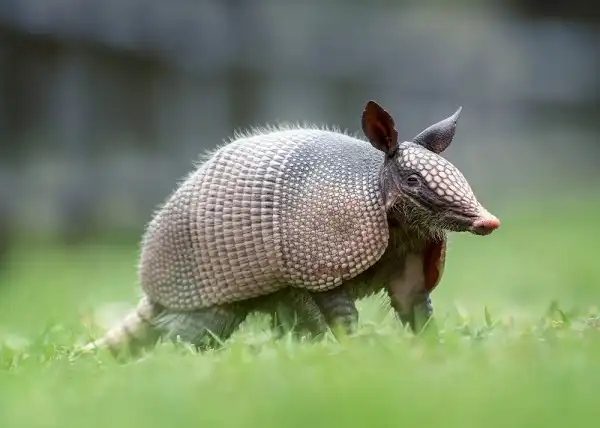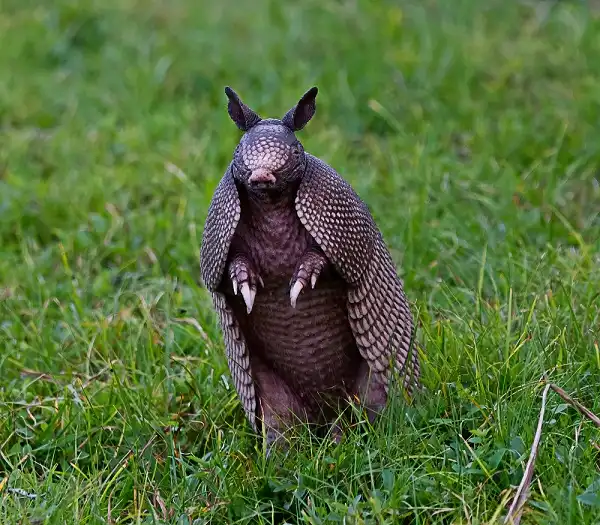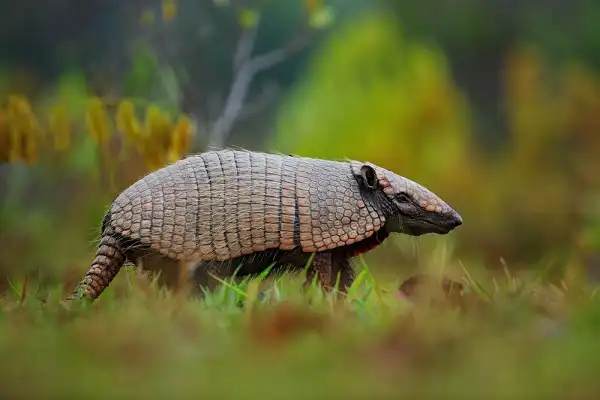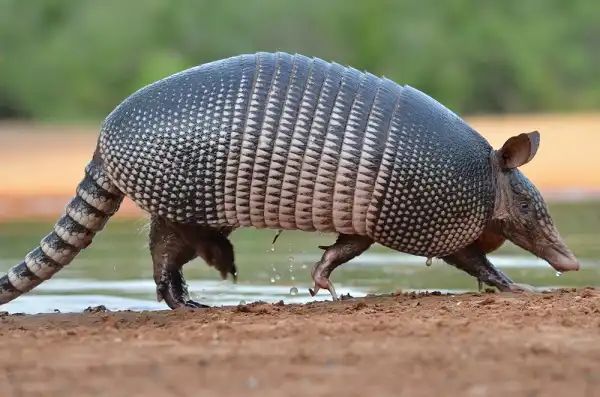The armadillo is a fascinating creature that has captured the imaginations of people for centuries. These unique animals are found in a variety of habitats across the Americas and have some interesting adaptations that help them survive in their environments. In this blog post, we’ll take a closer look at the armadillo and learn some interesting facts about these amazing animals.

Armadillo Description
The armadillo is a small mammal that belongs to the family of Xenarthra, which includes anteaters and sloths. This mammal is found in different habitats across the Americas, ranging from deserts to grasslands and even rainforests. They are heavily armored with thick plates of bone covered in leathery skin. The armor provides them protection against predators and helps them survive in harsh environments. These animals have some interesting adaptations that help them survive in their environment. Armadillos are burrowing animals and will dig up to two feet deep with their powerful claws. They also have excellent hearing which helps them detect potential predators in their surroundings. In addition, they can contract their body into a very tight ball when threatened for extra protection from attackers. Although not widely recognized as pets like cats or dogs, some people keep pet armadillos as exotic companions due to their unique looks and behaviors. However, they should be kept only by experienced owners as they require special care and diet to thrive properly.
Armadillo Habitat
The armadillo is found in a variety of habitats across the Americas, ranging from deserts to grasslands and even rainforests. They are well suited for life in these environments due to their thick armor plating covered by leathery skin providing protection against predators and strong claws enabling them to dig up food sources hidden beneath the surface. Deserts are one of the most common habitats for armadillos, particularly in South America. Here they inhabit areas with warm temperatures and sparse vegetation, where they can find insects, small mammals, lizards, and other prey items. During periods of intense heat or drought, armadillos will burrow underground to seek shelter from the extreme weather above ground. Grasslands are also an important habitat for armadillos as they contain a wide variety of plants that can provide food and shelter to these animals.
Armadillo Diet
Armadillos are omnivorous animals, meaning they eat both plant and animal materials. Their main diet consists of insects, as well as roots, fruits, plants, lizards, and eggs that they can find in their environment. Armadillos are active mostly at night when the temperatures are cooler but may become active during the day if temperatures drop below 40 degrees Fahrenheit (4 degrees Celsius). Insects make up the majority of their diet and they use their powerful claws to dig up larvae from underground. They will also consume a variety of fruit such as bananas, melons, and berries as well as plants like grasses, shrubs, and flowers. Lizards and other small animals found in their environment also make for a tasty snack for an armadillo. Their diet can vary depending on the season or availability of resources in their environment. During times of abundance, they may consume more plant material while during times of scarcity, they may switch to a predominantly carnivorous diet composed mainly of insects. Overall, armadillos require a balanced diet consisting of both animal and plant materials in order to stay healthy. In captivity, it is important to provide them with a variety of foods including insects such as crickets and mealworms along with fresh vegetables like carrots or sweet potatoes. They should also be given plenty of opportunity to explore their environment in search of natural food sources such as roots or fruits that would be available in the wild.

Armadillo Size
Armadillos are a diverse family of mammals known for their distinctive armor-like protective layer of scutes, or scales. The size of armadillos varies greatly between species and even individuals within the same species. Smaller armadillos such as the three-banded armadillo only reach lengths of 8 to 13 inches (20 to 33 cm) from head to tail while larger varieties like the nine-banded armadillo can grow up to 35 inches (89 cm) long. Armadillos also vary in weight depending on their size and species. The three-banded armadillo typically weighs between 1 and 2 pounds (0.5 to 1 kg). The larger nine-banded variety can weigh up to 15 pounds (7 kg), making it one of the largest members of its family. In addition to physical size, armadillos also differ in terms of girth or circumference around their body or individual segments such as legs or tails. A fully grown adult nine-banded armadillo may measure up to 18 inches (46 cm) around its midsection when standing upright with its tail stretched out behind it. Finally, some species possess an unusual form of bony armor called osteoderms which provide additional protection against predators by covering vulnerable areas such as their head and backside. These thick plates may reach up to 0.2 inches (0.5 cm) in thickness, giving them extra protection from sharp objects like claws and teeth that might otherwise penetrate their protective layer of scutes or scales.
Armadillo Lifespan
The lifespan of an armadillo is highly species-dependent, but in general, they live shorter lives than many other mammals. The three-banded armadillo, for example, typically lives between 5 and 8 years in the wild while the nine-banded variety can survive up to 15 years. The pink fairy armadillo is believed to have a life expectancy of only 3 to 4 years due to its small size and vulnerability to predation. The average lifespan of an armadillo is also affected by environmental factors such as food availability, climate, and competition with other wildlife for resources. Armadillos that inhabit more hospitable habitats may live longer than those residing in harsher regions where food sources are scarce or temperatures are extreme. Additionally, individuals that face frequent predation or extreme weather events may not reach their full life potential, leading to shorter lifespans overall. In captivity, however, armadillos can often reach much higher life expectancies due to the protection and safety of their enclosure as well as regular access to veterinary care and nutritious food sources. Studies have shown that some species can thrive for up to 20 years when provided with optimal living conditions such as clean housing areas and plenty of opportunities for physical activity.
Armadillo Behavior
Armadillos are known to exhibit both solitary and social behaviors. While some species primarily live alone, others may form loose colonies or family units in order to share resources and increase their chances of survival. During the day, armadillos use their keen sense of smell to forage for food as well as other signs of danger in their environment, such as predators or humans. They typically rest amongst burrows or rock crevices during the night but can become active if disturbed by loud noises or other disturbances in the area. When threatened, armadillos have a wide array of defensive strategies they can employ. The most common is the “freeze” response, which consists of standing stock still while making themselves as small and unappetizing as possible in order to avoid being seen or attacked. Other species may curl up into a tight ball so that only their armor-plating is exposed, protecting vital organs from potential damage caused by predators. Armadillos are also incredibly curious animals and often explore new areas with great enthusiasm when given the opportunity to do so. This behavior can sometimes result in them becoming trapped within fences or other objects blocking their way back home, which makes it important for owners to provide plenty of room and safe spaces for them to explore without endangering themselves.

Armadillo Speed
Armadillos are renowned for their surprisingly fast speed. Most species can reach up to 12 miles per hour while running, which is an incredible burst of speed considering their relatively small body weight. This allows them to escape from predators with ease and quickly find food sources or safe havens when needed. The specific speed of an armadillo depends largely on its size, terrain, and the resources available in its environment. Smaller species such as the pink fairy armadillo will usually be faster than larger ones like the giant armadillo due to their lighter body mass and more agile legs. Additionally, they may be able to move even faster on flat ground than they would in hilly or rocky areas where there is more resistance against their movement. In terms of acceleration, some species of armadillos have been recorded as reaching speeds over 60 miles per hour within just a few seconds of being startled by a predator or other disturbance! These impressive bursts of energy allow them to quickly travel vast distances and evade danger if necessary. In addition to running for short distances, armadillos can also “hitchhike” on top of other animals if needed in order to escape predators or find new food sources. For example, the nine-banded armadillo has been known to climb onto horses or cows in order to ride along with them while they graze in search of edible vegetation. This behavior helps them conserve energy while allowing them access to areas they otherwise wouldn’t be able to reach on foot alone.
Armadillo Hunting
Armadillo hunting is a popular activity among wildlife enthusiasts and hunters alike. Armadillos are highly sought after for their tasty meat, as it is said to be similar in flavor to that of pork. But hunting these animals does not come without risks or considerations. Armadillos can be quite elusive and hard to spot in their natural habitat due to their small size and excellent burrowing abilities. Their keen sense of smell can also make them more difficult to find, as they are able to detect predators from far away with ease. It is important for hunters to take extra precautions before attempting to capture an armadillo, such as using scent-eliminating clothes and other items designed specifically for wild game hunting. In addition to being challenging to hunt, armadillos also require additional care when handled by humans.
These animals have a delicate skeletal structure and should never be lifted without proper support or dropped from any height, as this could lead to serious injury or even death in the worst cases scenarios. It is best practice for hunters who wish to pursue this type of game animal to use humane trapping methods instead such as cage traps or box traps set with bait like fruit or corn meal. Overall, armadillo hunting requires dedication and caution in order to ensure safe and successful outcomes that both benefit the hunter and respect the animal’s rights simultaneously. Knowing what equipment is necessary beforehand as well as understanding how best to handle these animals both before and after they have been trapped will help protect them from any harm while providing a delicious meal at the same time!

Conclusion
All in all, armadillos are an amazing species of animal that have uniquely adapted to survive some of the harshest climates and environments around the world. From their impressive speed and agility to their ability to “hitchhike” on other animals, these creatures possess a variety of fascinating qualities that make them an interesting study for both wildlife enthusiasts and hunters alike. Understanding how best to approach these animals while out in nature is key in order to ensure their safety as well as your own. With the right knowledge and precautionary measures taken ahead of time, armadillo hunting can be an enjoyable experience with plenty of delicious rewards at the end!
Frequently Asked Question


